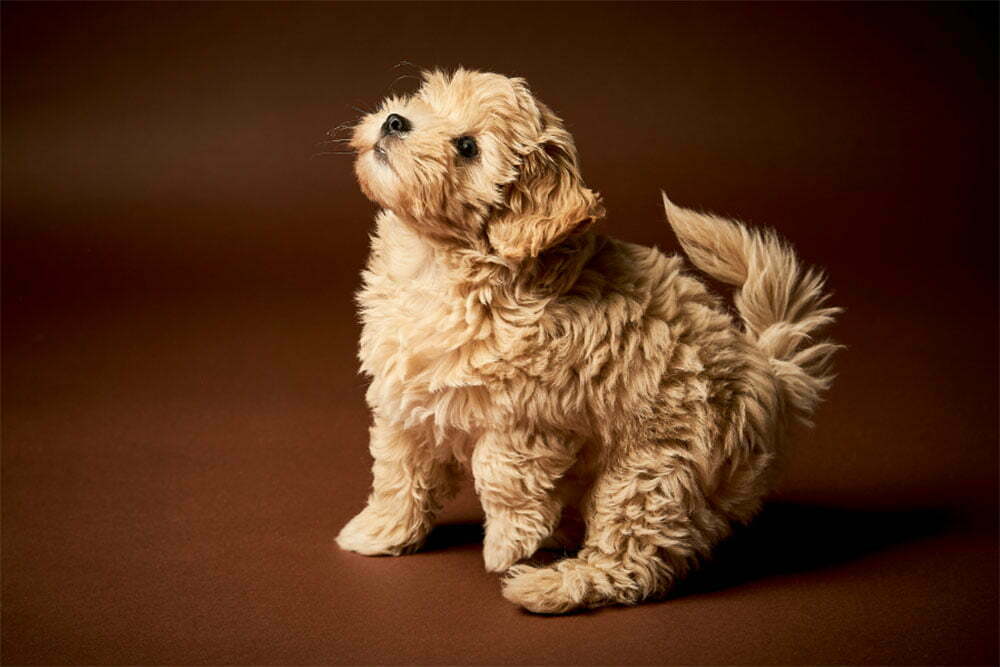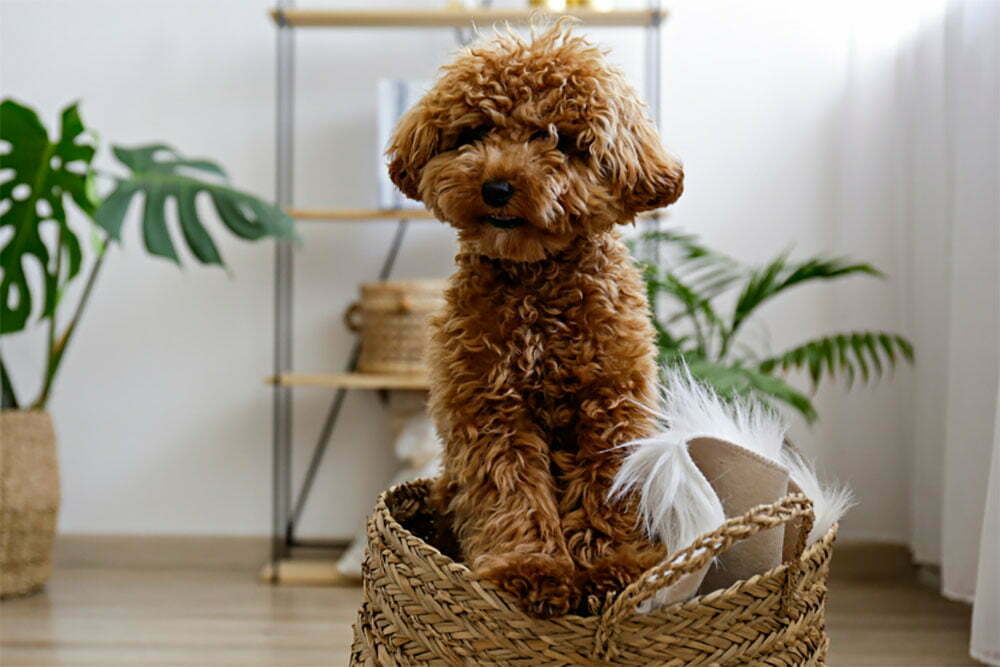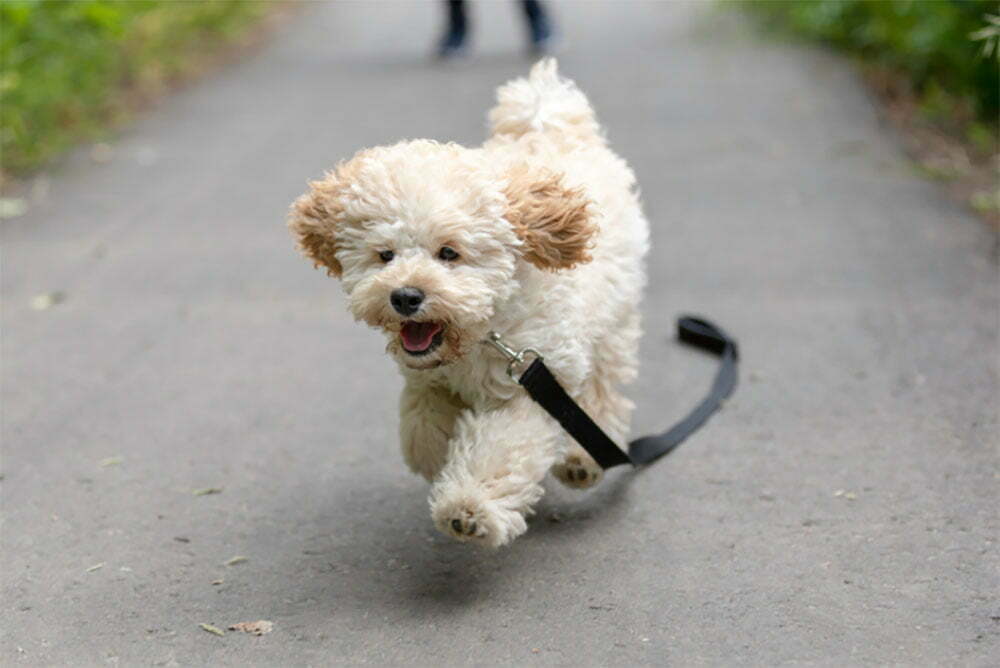Maltipoos are known for being sociable, intelligent, and loveable and swiftly winning the hearts of many pet parents.
It’s easy to see why so many people want to adopt these loving pups because they do well in both large and small households and play fetch as much as they love curling up on your lap.

But if you’re considering introducing a new dog into your family, it’s crucial that you do the necessary research before you make a hasty purchase. While Maltipoos can make a great addition to most households, there are some instances in which they may not be ideal.
Read on to our Ultimate Guide to learn everything you need about this adorable breed.
What is a Maltipoo?
A Maltipoo is a cross between a Maltese and a Poodle. The designer breed emerged in the United States at the start of the 1990s. Since then, the breed’s popularity has skyrocketed. They were supposed to be companions only, making them perfect pets.
Unfortunately, there is still a lot we don’t know about the history of designer dog breeds, but the largest mystery is where they came from. Aside from the well-known Labradoodle, few hybrid breeds have a well-documented history.
For so long, pure-breed dog snobs believed designer dogs to be little more than mutts that no one bothered to record their true origins. In many cases, the first litter was most likely created by chance.
Unlike many of the more established purebred dogs, we just don’t know where the majority of these gorgeous types of dogs originate from.
Maltese
The Maltese breed is from the island of Malta, which is located just south of Sicily. It is an ancient breed that has been around for thousands of years. They were adored by royalty and writers, poets, and painters. There are numerous works of art and literature based on this unique canine.
Poodle
The poodle grows in a variety of sizes, which is why the tiny Maltipoo exists. Although the standard Poodle was established in France and holds the title of National Dog, it first originated in Germany. Large Poodles were utilized as water retrievers, while smaller Poodles hunted truffles.
The Maltese x Poodle combination was a wonderful mix for the designer dog we have today. The Maltipoo can mix and match their sizes because of the Poodles’ size variation. Contrary to popular belief, their coat isn’t always white in color. In fact, Maltipoos can also come in black.
Physical Characteristics of the Maltipoo Dog Breed
Mixed breed dogs can have a wide range of appearances and characteristics, but the Maltipoo breed is quite consistent. That applies to both the puppy’s looks and personality.
This is because the tiny Maltese is bred to a Toy or Miniature Poodle that is similar in size and appearance, leaving little space for surprise. Maltipoos weigh 5 to 20 pounds and stand 8 to 14 inches tall. Female puppies are often smaller than male puppies.
Their heads are proportionate to the rest of their bodies. They have dark, wide eyes and short muzzles, which are perfectly complemented by dark noses and dark-colored, tight lips.
On either side of their head, their ears are placed high and wide apart, falling forward when alert or agitated but dropping down to the side when calm. The Maltipoo has a powerful jaw and a precise scissor bite, with their top teeth perfectly overlapping their lower ones.
For such small dogs, they have rather large chests and straight, short yet muscular front legs. Maltipoos have level backs and rounded loins, with well-laid back shoulders.
Their stomachs are somewhat tucked up, giving them an athletic appearance, and their back legs are strongly muscled and muscular—small, cat-like feet with powerful nails and paw pads.
The Maltipoo can have a very compact, curly coat or a much looser, wavy coat. They can also sometimes have a mixture of the two as it depends on which of the parent breeds they follow most.
Maltipoos can be found in a whole range of different colors, the most common of which include; cream, white, silver, apricot, black, brown, grey, red, and silver beige.
Personality traits of the Maltipoo breed
Maltipoos have inherited the brains of both parent breeds and the pleasant and caring personalities of the Poodle and the Maltese.
They are incredibly people-oriented, wanting to be with their humans as much as possible, which, while adorable, can become an issue when they are left alone for extended periods of time.

It’s important to note that Maltipoos can suffer from separation anxiety, which can cause them to become stressed out and disruptive around the house to reduce their tension when they are left alone.
They are an excellent choice for first-time pet owners who have plenty of time to devote to their animals.
As a result, Maltipoos thrive best in homes where at least one person stays home when everyone else is away. They are not ideal for families with very small children because they can be “snappy” when things get too loud and raucous.
They do, however, blend in well in families where the children are older and thus know how to behave appropriately around dogs.
Maltipoos enjoy the sound of their own bark, which is a behavior that should be gently discouraged when a dog is young to avoid it being a major issue when they are fully grown, older canines.
It is critical that both parent dogs are nice and friendly by nature so that puppies inherit their affectionate personalities. It is crucial to meet both parent dogs before purchasing a puppy, especially a Maltipoo.
A puppy’s socialization and training must begin as soon as they arrive in their new home. After they have been properly vaccinated, exposing them to a variety of new scenarios, noises, people, other animals, and pets is imperative so that they grow into calmer, more well-rounded mature canines.
Their training can also commence once they have received all of their vaccinations, and enrolling dogs in puppy classes is a fantastic way to get things off to a fine start. This is an excellent approach to continue socialization while also training them in a risk-free environment accompanied by other humans and dogs.
Health Traits of the Maltipoo Dog Breed
As purebred dogs have a restricted gene pool, certain breeds may experience recurring health problems.
Mixed-breed dogs have a bigger gene pool, which reduces a dog’s chances of inheriting specific health conditions. While this is good to a certain degree, it creates new difficulties.
When both parents of a mixed breed are predisposed to the same health problem, the chances of the mixed puppy inheriting that problem increase.
Patellar Luxation
This is when the kneecap moves out of place for a short period of time. The damaged leg becomes lame as a result of this. By hyperextending the knee, it should return to its original position.
It can cause lameness in the leg or may make a dog appear like they are skipping as they walk. Surgery is sometimes required to fix this problem.
Progressive Retinal Atrophy
This is a group of eye illnesses characterized by the slow degradation of the retina. Affected dogs become night-blind early in the disease; as the condition develops, they lose sight during the day.
As long as their surroundings do not change, many affected dogs adjust well to their reduced or lost vision.
White Dog Shaker Syndrome
Only white dogs are affected by this sickness. It causes uncontrollable shaking of the body. West Highland Terriers, Maltese, Poodles, and Bichons are the most commonly affected breeds.
Legg Calves Perthes Disease
This is an excruciatingly painful hip ailment. It causes a limp, and the dog eventually stops being able to put its whole weight on the affected leg. Smaller dog breeds are particularly vulnerable to this disease.
The disorder results in reduced blood flow to the apex of the femur bone. This causes the femoral head to degenerate, resulting in muscular atrophy, limping, or discomfort. Surgery can frequently repair this and allow a dog to walk pain-free.
Portosystemic Shunt
This is a type of abnormal vessel that allows blood from the intestine to bypass the liver. This accelerates the degradation of liver function. It can eventually lead to death if it’s left untreated for extended periods of time.
Epilepsy
This neurological disorder is frequently, but not always, hereditary. Seizures caused by epilepsy can be moderate or severe, manifesting as strange behavior (such as running furiously as if being followed, staggering, or hiding) or even falling down, limbs rigid, and losing consciousness.
Seizures are terrifying to witness, but the long-term prognosis for dogs with idiopathic epilepsy is often extremely excellent. Taking your dog to the vet for accurate diagnosis (particularly since seizures can be caused by other factors) and treatment is critical.
How long does a Maltipoo live?
Despite the fact that the average lifespan of all canines is between 10 and 13 years. Smaller dogs, such as the Maltipoo, have a somewhat longer life expectancy of 12 to 16 years. You might also be interested to know that female dogs live roughly 1 to 1 ½ years longer than male canines.
Some people believe that mixed breeds, such as the Maltipoo, have longer lives than purebreds. However, there have been no solid studies to support this claim. Some studies have found that some health conditions are less prevalent in cross-breeds, but not all.
How to take care of a Maltipoo dog
Exercise
A Maltese x Poodle should have 40 minutes of exercise every day, divided into two 20-minute walks. Your owner’s responsibility is to keep your dog in shape and healthy.
Harnesses are needed for this breed since the neck of toy/small breeds is more delicate, so using just a collar alone could cause him extreme discomfort.

This canine might go on an adventure. Because of their small stature, they may be injured. This is why a Maltipoo dog should not be let off the lead unless in an enclosed environment.
Maintaining an exercise plan will help you leave your pet alone for a few hours.
Maltipoos can develop negative behaviors if their exercise requirements are not met. They can also become hyperactive and agitated. You don’t want your dog to develop a chewing habit or other attention-seeking habits.
Training
Training a Poodle/Maltese mix is simple if the trainer is patient and loving. Maltipoos are extraordinarily intelligent, yet they are also extremely sensitive.
Positive reinforcement training approaches are the only ones that work for this designer dog. Harsh speech, yelling, or forceful approaches will cause the dog to cower and shut down. This will severely limit the possibility of training.
Not to mention that these harsh training methods will harm your bond with your pet. This is very close to abuse and should be avoided at all costs. Instead, use gentle “bribes” to convince your dog to obey.
Yummy snacks and enthusiastic praise will make the Maltipoo delighted to begin his training sessions and keep him interested in working. You’ll be surprised at how quickly you can train these puppies with a soft touch.
Maltipoos can thrive in obedience and agility scenarios and be quick learners in housebreaking and simple commands. They are also excellent therapy dogs. These dogs offer delight to everyone they meet.
Grooming
Maltipoo coats can range from smooth and soft to thick and curly and can be anything from Poodle curls to the long silky coat of the Maltese. They are unlikely to shed much, if at all, but they will need to be trimmed regularly and brushed every other day.
Find a good local groomer who can either take care of your Maltipoo’s coat or show you how to do it yourself as their coat grows.
Also, it’s important to note that dog ear care is critical because Poodles often have issues with excessive hair inside the ears, which can lead to infections or irritated ears.
The average price of a Maltipoo
Maltipoo costs can range from $500 to more than $2,500, with a price range of $800 – $1,000 being the most frequent. A breeder’s reputation and location; a puppy’s age, size, lineage; and current demand can all impact the price.
All three probable parent breeds of the Maltipoo have inherited health issues, and professional breeders do health testing on their parent stock before breeding. This costs money and hence raises the asking price for future puppies.
Puppies with health-tested parents lead to higher price tags because their health is more secure, and breeders must also consider the cost of being unable to responsibly breed and sell dogs and puppies with poor health test results, which is passed on to buyers of other pups as a general cost of doing business.
Frequently Asked Questions
Are Maltipoos hypoallergenic?
People who breed Maltipoos aim to produce a hypoallergenic dog because both Poodles and Maltese are non-shedders. If you’re allergic, it’s crucial to understand pet allergies before purchasing a Maltipoo.
All dogs shed dander (dead skin flakes) and saliva, both of which include allergens. Allergies might also develop over time.
You may not react to a dog when you first meet him, but you may acquire an allergy after a few days, weeks, or even months of living with him. Spend a lot of time with a variety of Maltipoos to see how you react.
Are Maltipoos suitable for first-time owners?
Maltipoos are a fantastic choice for first-time or apprehensive dog owners. They are simple to train, and they pick up commands very quickly. They also thrive in homes with elderly people or older children who can handle them with care.
They appreciate long cuddling and are attentive to the wishes and requirements of their owners.
Maltipoos can live in almost any type of household, from an apartment to a townhouse. They enjoy being with their people and should live indoors with their human families rather than outside or in kennels.
They are not advised for homes where they will be left alone for extended periods of time.
Are Maltipoos good with children?
Maltipoos could be an excellent addition to your household. They enjoy going for walks and playing just as much as they do curling up on your lap for some one-on-one time.
While Maltipoos are excellent for children but usually better for families with slightly older children.
Younger children may inadvertently be too harsh with these small dogs, so watch the child and the dog when they interact.
If your Maltipoo will be joining a family with other pets, keep an eye on their first encounter and introduce them in a neutral and controlled environment.
